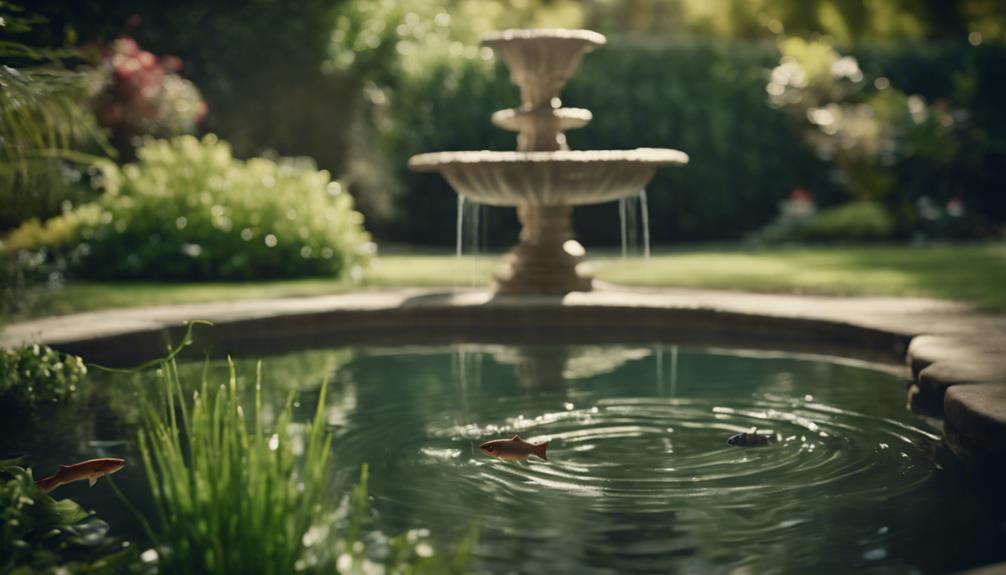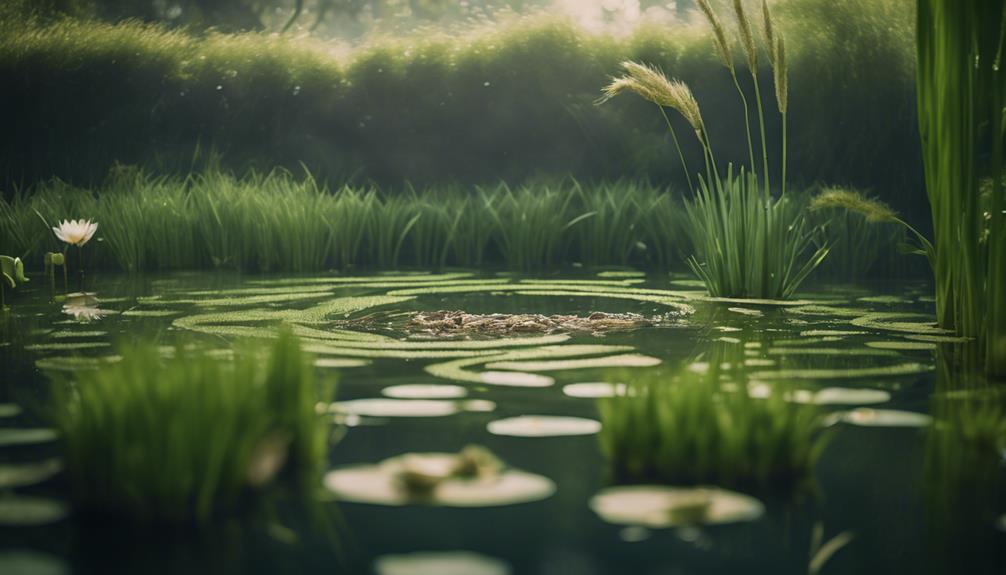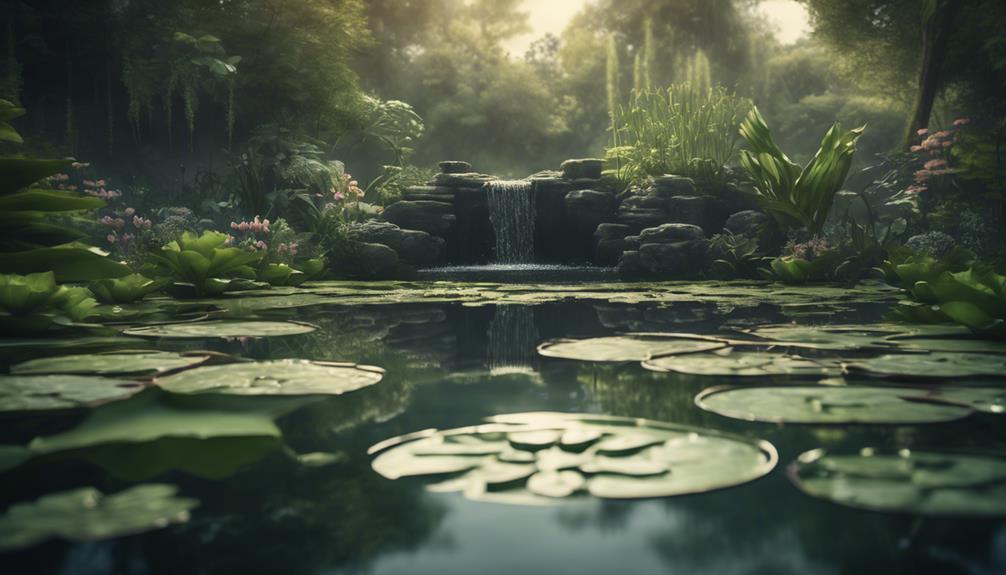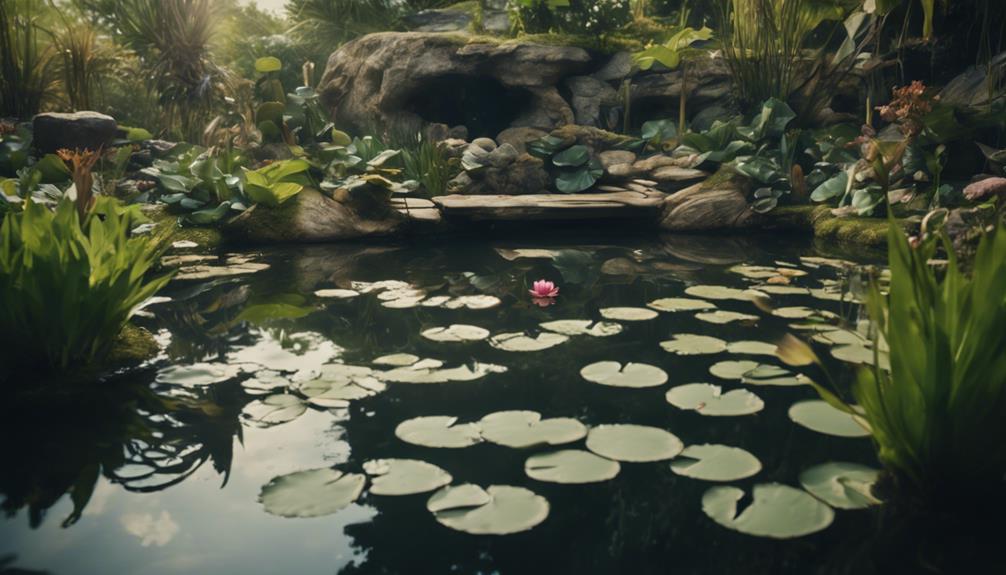You can naturally control algae in your garden pond by addressing its root causes. Excess nutrients, direct sunlight, and inadequate filtration fuel algae growth, so crucially necessary to introduce natural algae inhibitors like barley straw and beneficial bacteria. Beneficial plants like water hyacinth and water lettuce compete with algae for resources, while a well-aerated pond promotes aerobic bacteria that break down organic matter. Regularly monitor and maintain your pond's ecosystem by controlling nutrient buildup, reducing excess sunlight, and implementing natural methods. By taking these steps, you'll be on your way to creating a balanced ecosystem where algae struggles to thrive, and there's more to explore to achieve ideal results.
Table of Contents
Key Takeaways
- Introduce beneficial plants like water hyacinth and water lettuce to compete with algae for resources and provide shade.
- Implement aeration methods like waterfalls and air stones to introduce oxygen, creating an environment where algae struggle to thrive.
- Use natural algae inhibitors like barley straw, which releases compounds that inhibit algae growth when it decomposes.
- Maintain a balanced ecosystem by promoting aerobic bacteria, which break down organic matter and prevent algae overgrowth.
- Control nutrient buildup by reducing excess nutrients through regular water changes, proper filtration, and nutrient-absorbing plants.
Understanding Algae Growth
When you explore the world of pond management, understanding the underlying factors that drive algae growth is vital, as these primitive plants can quickly take over your serene garden oasis.
Through photosynthesis, algae combine water and carbon dioxide to form sugars for energy and growth, producing oxygen as a by-product. However, algae would otherwise absorb nutrients from the pond water, leading to rapid growth and potentially harming aquatic life.
You may notice two main types of pond algae: green water algae, which remain suspended in water, and filamentous algae, which grows in long strands and adheres to rocks and waterfalls.
The growth of algae is fueled by excess nutrients in the pond water, often introduced through tap water, fish food, and garden soil. Additionally, direct sunlight, lack of oxygen, and inadequate filtration and circulation can exacerbate algae problems.
Natural Algae Control Methods
As you explore natural algae control methods, you'll find that introducing specific plants and microorganisms to your pond can be a highly effective approach.
By leveraging the competitive advantages of certain plants and the beneficial effects of natural inhibitors, you can create an ecosystem that discourages algae growth.
Let's examine the two key strategies for achieving this balance: plant-based algae control and natural algae inhibitors.
Plant-Based Algae Control
You can effectively combat algae growth in your garden pond by introducing certain aquatic plants that absorb excess nutrients, thereby starving the algae of its food source. These plants not only help control algae but also enhance the overall aesthetic of your pond.
Some beneficial aquatic plants to ponder:
- Oxygenating plants: These submerged plants, like hornwort and cabomba, produce oxygen during the day, which helps to reduce algae growth.
- Floating plants: Plants like water lettuce and water hyacinth absorb excess nutrients from the water, reducing the amount available for algae to grow.
- Marginal plants: Plants like cattails and irises, which grow in shallow water, help stabilize the pond's ecosystem and reduce algae growth.
- Water lilies: These plants not only provide shade, which can reduce algae growth, but also absorb excess nutrients.
- Submerged plants: Plants like anacharis and elodea absorb nutrients from the water, reducing the amount available for algae to grow.
Natural Algae Inhibitors
Certain aquatic plants and microorganisms can function as natural algaecides, inhibiting algae growth and promoting a balanced ecosystem in your garden pond.
For instance, when barley straw decomposes, it releases compounds that inhibit algae growth, making it a natural and effective algae control method. Additionally, beneficial bacteria consume algae, breaking down organic matter and preventing algae overgrowth.
These natural algaecides are safer and more sustainable than chemical treatments, although they may take longer to show results.
A well-aerated pond also promotes the health of aerobic bacteria, which break down organic matter and prevent algae overgrowth.
Plants like water lilies, hornwort, and duckweed outcompete algae for resources, helping to control algae populations naturally.
By incorporating these natural algae inhibitors into your pond's ecosystem, you can create a balanced and thriving environment.
Remember, Ultraviolet (UV) light can also be used to control algae, but it's crucial to use it in conjunction with these natural methods for ideal results.
The Power of Aeration

Frequently, a well-designed aeration system is the key to maintaining a balanced ecosystem in your garden pond. By introducing oxygen into the water, you create an environment where algae struggle to thrive. This is because aerobic bacteria, essential for a balanced ecosystem, break down organic matter and prevent algae overgrowth.
Aeration methods, such as waterfalls, fountains, air stones, and windmills, introduce oxygen into the water, creating an environment where algae struggle to thrive.
Aerobic bacteria convert ammonia and nitrite into harmless compounds, reducing the availability of nutrients for algae growth.
Proper aeration helps to reduce stratification, where warmer water floats on top of cooler water, which can lead to algae blooms.
Aeration can increase the oxygen levels in the pond by up to 30%, making it difficult for algae to grow and survive.
A well-aerated pond promotes the health of aerobic bacteria, which are essential for breaking down organic matter and preventing algae overgrowth.
Beneficial Plants for Algae Control
In addition to aeration, incorporating beneficial plants into your garden pond's ecosystem can provide a natural and effective way to control algae growth, as these plants compete with algae for resources like nutrients and light.
You can introduce plants like water hyacinth, which not only consume algae but also provide shade, reducing the amount of light available for algae to grow.
Furthermore, beneficial plants and bacteria work together to break down excess nutrients, making it harder for algae to thrive.
By adding these plants to your pond, you're creating a balanced ecosystem where algae growth is naturally suppressed.
As you cultivate a thriving community of beneficial plants, you'll notice a significant decrease in algae growth.
This approach isn't only environmentally friendly but also requires minimal maintenance.
By working with nature, you'll be able to enjoy a clear and healthy pond that's teeming with life.
With beneficial plants on your side, you can bid farewell to algae woes and hello to a serene and peaceful outdoor space.
Barley Straw and Other Remedies

By incorporating barley straw into your pond's ecosystem, you can harness the power of natural compounds that inhibit algae growth, providing a gradual and long-lasting control method. Barley straw releases compounds that inhibit algae growth when it decomposes, making it a natural and harmless way to remove algae from ponds.
Place the barley straw in a mesh bag and anchor it where water flows over it for optimum results.
Be patient, as the decomposition process can take several weeks to show results, requiring regular monitoring of pond conditions.
The humic acid produced by the decomposition of barley straw reacts with water and sunlight to kill algae.
This method is cost-effective and environmentally friendly, making it a popular choice among pond owners.
Maintaining a Balanced Ecosystem
You can create a robust defense against algae by cultivating a balanced ecosystem in your garden pond, where a diverse array of plants, fish, and bacteria work together to prevent algae overgrowth.
A balanced ecosystem is the best defense against algae, where a healthy mix of aquatic life creates an environment where algae struggle to thrive.
Aerobic bacteria, which break down organic matter, play a vital role in preventing algae overgrowth. A well-aerated pond promotes the health of these beneficial bacteria, and you can achieve this through aeration methods such as waterfalls, fountains, air stones, or windmills.
Different types of ponds require different plants, such as water lilies, hornwort, and duckweed, to control algae growth. These plants consume the same nutrients as algae, outcompeting them for resources.
Regular monitoring and maintenance of pond water conditions are pivotal to maintaining a balanced ecosystem, allowing you to promptly detect and respond to any changes that may favor algae growth.
Controlling Nutrient Buildup

As you work to control algae in your garden pond, you'll need to focus on reducing the nutrient buildup that fuels its growth.
You can do this by implementing nutrient reduction methods and preventing excess nutrients from entering the water.
Nutrient Reduction Methods
Reducing excess nutrients is essential to preventing algae growth, and several strategies can be employed to minimize their buildup in your garden pond.
You can take control of nutrient reduction methods to create a balanced ecosystem.
Remove organic matter, such as decaying plants and fish waste, which can fuel algae growth.
Use high-quality fish food that's low in phosphorus and nitrogen, as these nutrients can contribute to algae blooms.
Implement regular water changes to dilute excess nutrients and remove algae.
Add plants that absorb excess nutrients, such as water lilies or cattails, to create a natural balance.
Consider using a pond skimmer or filter to remove debris and excess nutrients from the water.
Prevent Excess Nutrients
By incorporating these nutrient reduction methods into your regular pond maintenance routine, you'll be well on your way to preventing excess nutrients from building up in the first place.
Excess nutrients are the primary driver of algae populations, so crucially, you must keep them under control.
Fish waste, decaying plant matter, and runoff from surrounding soil can all contribute to nutrient buildup in your pond's ecosystem.
To prevent this, make sure to remove any dead plant material and excess fish food from the pond regularly. You can also consider adding plants that absorb nutrients, such as water lilies or cattails, to your pond.
Additionally, avoid using harsh chemicals or fertilizers in your garden, as these can run off into your pond and exacerbate the problem.
Putting It All Together
You've now gathered a thorough understanding of the various methods to control algae in your garden pond, and it's time to integrate these strategies into a cohesive plan.
By combining these approaches, you'll be well on your way to getting rid of algae and enjoying a thriving, balanced ecosystem.
To create a thorough plan, consider the following key elements:
Balance your pond's ecosystem: Make sure your pond has a healthy balance of plants, fish, and beneficial bacteria to keep algae in check.
Limit direct sunlight: Provide shade for your pond, especially during peak sun hours, to prevent algae growth.
Maintain good water circulation: Verify your pond has adequate water movement to prevent stagnation and reduce algae growth.
Monitor and adjust nutrient levels: Regularly test your pond's water for excess nutrients and take steps to reduce them, such as adding plants or adjusting fish feed.
Regularly clean your pond: Perform regular water changes and clean your pond's filters to remove algae and excess nutrients.
Frequently Asked Questions
How to Get Rid of Green Algae in a Garden Pond?
You'll effectively get rid of green algae in your garden pond by implementing algae prevention methods, such as pond aeration and water circulation, introducing algae eaters, achieving pond balancing, and utilizing ultrasonic devices to maintain a healthy ecosystem.
How to Remove Algae From Water Plants Naturally?
Did you know that 70% of pond water can be filtered by aquatic plants in just 24 hours? You can remove algae from water plants naturally by leveraging plant filtration, which enhances water clarification, promotes natural balance, and supports aquatic health within your pond ecosystem.
Does Vinegar Kill Algae in Ponds?
You'll find that vinegar benefits your pond by preventing algae growth, creating an acidic environment that inhibits its development, making it a natural and eco-friendly method for pond maintenance, although it may require repeated applications.
Does Baking Soda Kill Algae in Ponds?
You'll find that baking soda doesn't directly kill algae, but it helps prevent growth by raising the pH level and removing carbon dioxide, a growth factor; use 1-2 tablespoons per 10 gallons, monitoring pH and alkalinity levels to avoid harming aquatic life.
Conclusion
Naturally controlling algae in your garden pond requires a multi-faceted approach.
By understanding algae growth, utilizing aeration, beneficial plants, and remedies like barley straw, you can maintain a balanced ecosystem.
Notably, did you know that a single pound of phosphorus can stimulate the growth of up to 1,100 pounds of algae?
By controlling nutrient buildup, you'll be well on your way to a thriving, algae-free pond.

